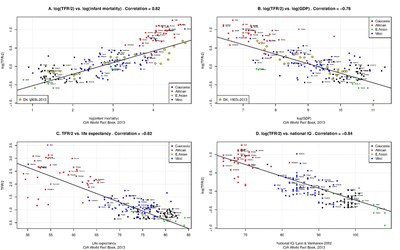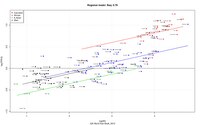User:Thomas.lill.madsen/sandbox
Correlates of TFR[edit]

Numerical correlates of TFR in x-sectional data are ia. infant mortality (IM), GDP (per capita), life expectancy and national IQ. These variables are all closely intercorrelated and are part of the development nexus.
Normally one cannot take for granted that cross-sectional and longitudinal data have the same parameters. Therefore it is perhaps interesting in panel A and B that two time series from the danish experience over the last 110 years (yellow dots) are plotting within the x-sectional pattern of data (source:Statistikbanken.dk).

Relative to these correlates, African TFR appears to be 30-90% higher than expected from the general pattern set by other regions. Eg. from the relation based on infant mortality as a measure of development it appears that African fertility is 66% higher than in Western countries, net of IM. As a contrast, TFR in the East Asian group is 20% lower. If there is an ethnic component in this, adaptions made over the last 100,000 years to different geographic latitudes might be part of the explanation. The parental investment in children is less in a warm climate where chilren from an early age can take part in foraging, relative to the cold regions where exsistence was based primarily on hunting large animals.
TFR and population growth rate[edit]

TFR (net) and long term population growth rate, g, are closely related. It is easily seen that, for a population structure in a steady state, g = log(TFR/2)/Xm and thus P(t) = P(0)*exp(g*t), where Xm is mean age for childbearing women.- Below is shown the empirical relation between the two variables in a cross-section of countries. The parameter 1/b is an estimate of the Xm; here equal to 1/.02 = 50 years,- clearly an impossible value caused by inertia in population growth such that growth rates reflect earlier, and higher, TFR. Eg. for log(TFR/2) = 0 g should be exactly zero, which is seen not to be the case.

